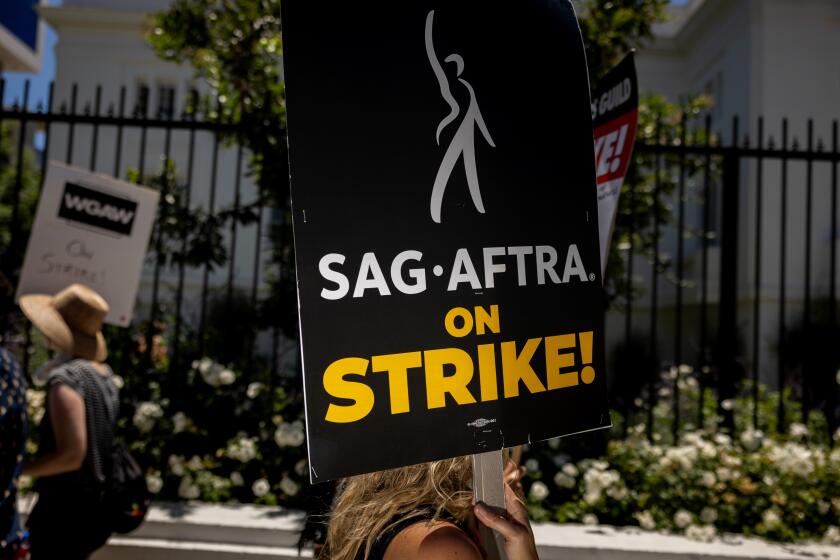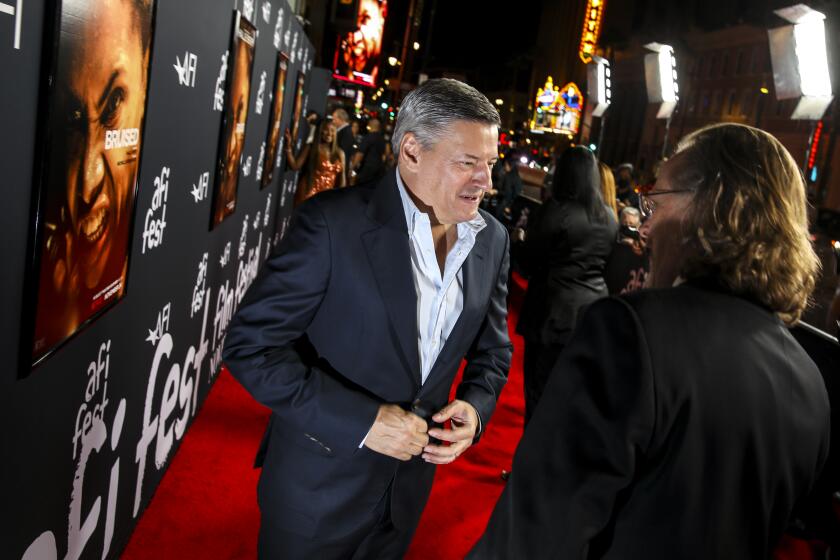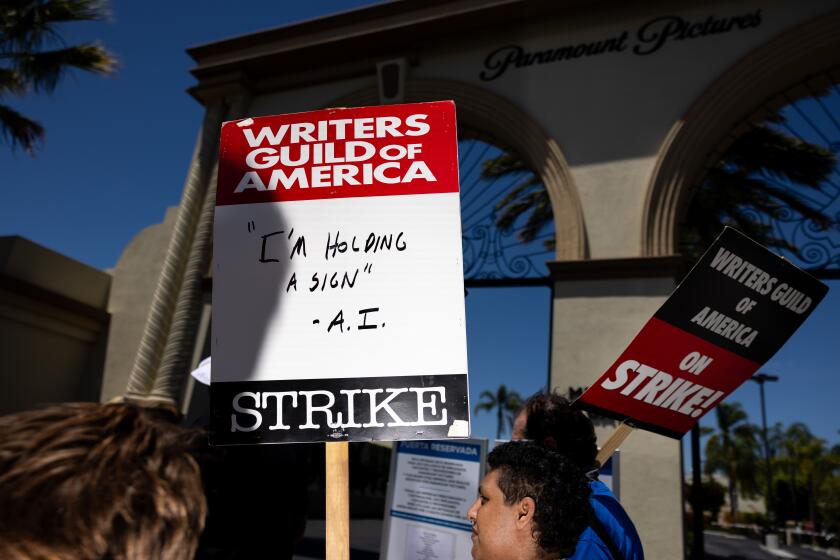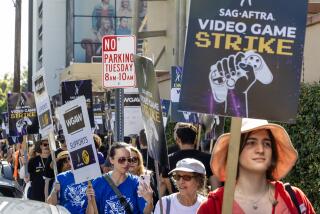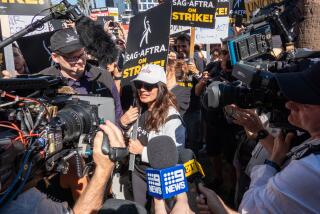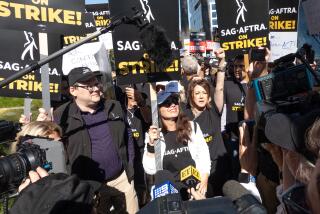SAG-AFTRA talks break down over streaming pay in a setback for Hollywood’s back-to-work plans
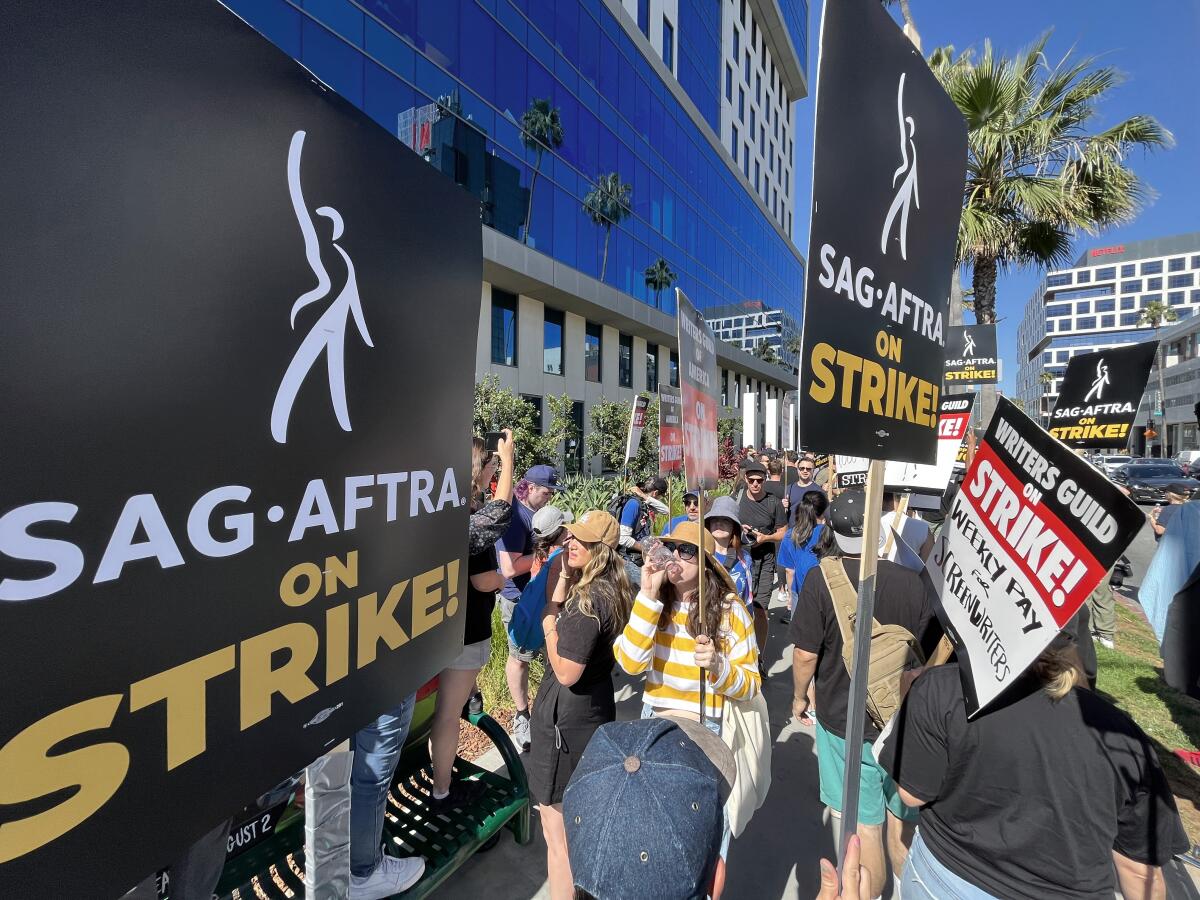
Hollywood’s plan to get back to work just got more complicated.
Hopes of an imminent resolution to the three-months-old actors’ strike dimmed this week after talks between SAG-AFTRA and the major studios broke down because of a sharp disagreement over how performers ought to be compensated from streaming, a development that threatens to prolong the industry-crippling strike.
The film and television industry viewed last week’s restart of negotiations with high expectations that the companies and the guild would quickly reach an agreement to finally revive the production of movies and TV shows that have been shut down since spring.
But a Wednesday disagreement has once again heightened fears that the labor dispute could stretch on for weeks — if not through year’s end.
The entertainment companies, represented by the Alliance of Motion Picture and Television Producers, hit the pause button on the talks Wednesday night, saying the sides remained too divided.
“After meaningful conversations, it is clear that the gap between the AMPTP and SAG-AFTRA is too great, and conversations are no longer moving us in a productive direction,” the studio alliance said in a statement.
For its part, the Screen Actors Guild-American Federation of Television and Radio Artists accused the alliance of using “bullying tactics,” in a note to members from the negotiating committee that was sent Thursday morning.
“We want to see progress in these negotiations so the strike can come to an end,” SAG-AFTRA Chief Negotiator Duncan Crabtree-Ireland said in an interview. “Them walking away from the table doesn’t allow that. The only way this can move forward is for us to be talking to each other.”
The AMPTP reached a separate agreement in late September with the Writers Guild of America, which had been on strike for nearly five months. That pact, ratified this week with 99% of WGA voters’ approval, was celebrated as a major step toward getting the business back on its feet.
The SAG-AFTRA sessions, which restarted Oct. 2, have included participation of key industry leaders, including Walt Disney Co. Chief Executive Bob Iger, Netflix co-CEO Ted Sarandos, Warner Bros. Discovery CEO David Zaslav and NBCUniversal Studio Group Chairman Donna Langley. SAG-AFTRA President Fran Drescher has become a forceful advocate in the room for guild members, telling the companies that they needed to share a bigger slice of the pie with performers.
The sides described progress as slow.
SAG-AFTRA on Wednesday submitted a package of counter proposals, Crabtree-Ireland said. At about 5:30 p.m., he began receiving calls from company CEOs saying the AMPTP was going to withdraw from the talks. A session that had been scheduled for Thursday was canceled.
The issue of streaming pay — a focus of both the writers’ and actors’ strikes — is what threw a wrench in the studios’ back-to-work plans.
SAG-AFTRA has approved a deal from the studios to end its historic strike. The actors were on strike for more than 100 days.
Company executives had rebuffed the union’s initial demands to share 2% of streaming revenue, which would be in addition to existing residuals. Legacy entertainment companies are still losing money on direct-to-consumer services as they try to transition away from the traditional pay-TV business.
The guild came back with a proposal that streaming services pay actors on a per-subscriber basis, an idea that the studio leaders considered an overreach, according to company sources.
The AMPTP said such a concession would cost the companies more than $800 million per year and “create an untenable economic burden.” Studio sources suggested that the actors guild had essentially asked the companies to pay $1 per subscriber a year.
Sarandos, speaking at a media industry conference, called the guild’s request a “levy” on every streaming subscriber.
“I know that all these guilds are not created equal and they all have different needs and more bespoke needs,” Sarandos said Thursday at Bloomberg’s Screentime event in Los Angeles. “But a levy on top of our revenue or per subscriber with no insight into the revenue per subscriber or anything, we just felt like a bridge too far.”
Crabtree-Ireland said the union’s proposal amounted to about 57 cents per subscriber annually from the various streaming services, not the $1 that studios sources had claimed.
“When you think about the fact that these companies bring in billions and billions of dollars from almost a billion subscribers combined,” Crabtree-Ireland said, “that’s not a lot to ask for people whose performance and face and voice represents the content that gives these streaming platforms the ability to have subscribers.”
Instead, the AMPTP said it had offered SAG-AFTRA “a first-of-its-kind success-based residual for” subscription-based streaming productions. Such language suggests a deal similar to that of the performance-based streaming bonus system won by the writers, which allows scribes to earn additional payment if 20% of a service’s domestic subscribers watches their program during the first 90 days of release.
The AMPTP’s statement contained numerous bullet points summarizing its offers to SAG-AFTRA, hoping that rank-and-file actors and industry professionals would see the studios’ proposals as reasonable compromises and apply pressure to Drescher and Crabtree-Ireland.
The studio group touted what it described as generous increases in minimums, foreign streaming residuals, pension and health contribution caps and relocation allowances. The AMPTP said its offer represented the highest percentage increase in minimums in 35 years, and would generate an additional $717 million in wages and $177 million in contributions to the pension and health plans during the contract term.
The alliance took a similar tack when its members became frustrated with the progress of talks with the WGA. After an Aug. 22 meeting between WGA leaders and the studio chiefs, the AMPTP released a six-page document laying out the details of its proposal.
The WGA balked at the tactic, decrying it as an attempt to circumvent the negotiating committee. AMPTP members are convinced that releasing its deal points helped move discussions along by letting writers see that the studios had made concessions. In the end, more picketing followed, but the two sides ultimately returned to the table to make a deal.
“The industry is trying to break the union,” said 55-year-old actor Rodney Allen Rippy, who has worked on movies including “Blazing Saddles” and spoke to The Times by phone. “They are trying to muscle them and manhandle the actors in a way and that’s not fair.”
The union negotiating committee said: “The companies are using the same failed strategy they tried to inflict on the WGA — putting out misleading information in an attempt to fool our members into abandoning our solidarity and putting pressure on our negotiators. But, just like the writers, our members are smarter than that and will not be fooled.”
Film and TV actors have been on strike since mid-July. The actors guild is seeking greater compensation and higher residuals, in addition to revenue sharing and greater protections against the use of artificial intelligence.
The two sides are also struggling over how to reach common ground on the use of generative artificial intelligence, which actors say represents a threat to their livelihoods. Studios have already used AI technology to de-age actors and create dubs using replicas of famous actors’ voices.
AMPTP said its proposal offers that “no Digital Replica of the performer can be used without the performer’s written consent and description of the intended use in the film” and “prohibition of later use of that Replica, unless performer specifically consents to that new use and is paid for it,” among other protections.
Viewership data from streaming services such as Netflix and Disney+ has become a major sticking point in the writers’ and actors’ strikes.
But SAG-AFTRA says the alliance’s proposal doesn’t offer enough protections, adding the studios want to “demand ‘consent’ on the first day of employment for use of a performer’s digital replica for an entire cinematic universe (or any franchise project).”
Executives fear that another month of the strike would prevent TV networks from airing new original episodes until late spring or summer. It also could spell doom for the movie studios’ theatrical releases for next summer — the most important season of their year. Some films that were planned for next year’s release shut down production before filming was complete.
Concerns about AI were a sticking point in the now-ended writers’ strike. But equivalent issues could prove stickier for actors, who remain on strike.
Ari Emanuel, chief executive of the entertainment company Endeavor, expressed frustration at the slow pace of talks. “It’s affecting a lot of people, and a lot of people are hurting,” Emanuel, whose company owns talent representation firm WME, said at the Bloomberg conference. “You’re not winning an Oscar for this negotiation.”
More to Read
Inside the business of entertainment
The Wide Shot brings you news, analysis and insights on everything from streaming wars to production — and what it all means for the future.
You may occasionally receive promotional content from the Los Angeles Times.
